
Home » Travel Guides » Germany » 25 Best Things to Do in Düsseldorf (Germany)

25 Best Things to Do in Düsseldorf (Germany)
As an international financial giant, Düsseldorf has a well-to-do reputation underpinned by its chic shopping street Königsallee and the revitalised harbour where the big names in architecture have contributed buildings.
The city has an earthier side too, and residents and tourists let their hair down and quaff the local Altbier in the historic Altstadt which has hundreds of bars.
In July there’s an explosion of fun and levity at the Kirmes fair, a public celebration that is only exceeded by Oktoberfest for scale.
And there’s so much culture you may not know where to begin: The city has historic residences and parks built by Imperial Electors, art museums for all eras, cultural centres and medieval churches.
Let’s explore the best things to do in Düsseldorf :
1. Rheinuferpromenade

When the sun is out it might feel like the whole city has decided to come for a wander at this promenade on the right bank of the Rhine.
The walkway is positioned so that it gets sunshine all day long, and bends from the Parliament down to the harbour.
The first promenade appeared at the turn of the 20th century, but it’s only since 1993,when road traffic was redirected underground, that it’s been possible to amble next to the Rhine in peace.
In summer the scene is almost Mediterranean, in the way the facades glow in the sun at sunset, and long rows of restaurant and cafe terraces are packed with people chatting.
At Burgplatz there’s a stairway where people park themselves to read books in the sun, and jetties on the water for cruises on the Rhine.
- 2. Altstadt

The old town is by no means large, but if you’re planning a night out in Düsseldorf there are more nightspots than you could ever hope to visit.
Packed into just a few streets are 300 brewpubs, bars and nightclubs, to the point where the area is referred to as the “Längste Theke der Welt”, “The longest bar in the world”. Although there’s no way to prove it, each bar is claimed to connect with the one next door.
The brewpubs in the quarter serve traditional Altbier, which we’ll talk about in more detail later.
Also take some time to explore with a clear head during the day, checking out the adorable gabled houses and the many cultural amenities in the quarter, like the Kunstsammlung Nordrhein-Westfalen, the Filmmuseum and the NRW-Forum.
3. Königsallee
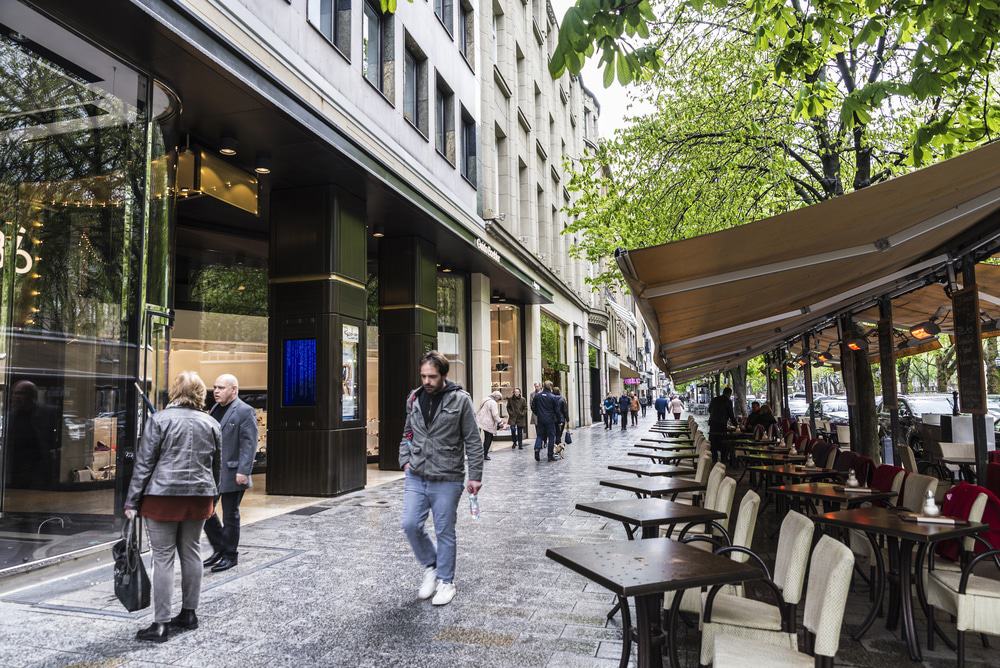
If Düsseldorf is a byword for luxury and high-end lifestyles it’s because of Königsallee, a plush shopping boulevard either side of a canal lined with plane trees.
The name is usually contracted to “Kö” by locals, and the street runs for a kilometre north to south, with every premium brand under the sun on the way.
For most people it’s a chance to do some window shopping, soak up the affluent ambience and take some photos of the canal and its elegant bridges.
But if there’s something very special you need, you’re sure to find it at one of the many flagship stores.
Chanel, Cartier, Tiffany & Co, Burberry, Gucci, Louis Vuitton, Hugo Boss and Prada are just a selection.
4. Medienhafen

At the southern end of the Rheinuferpromenade are Düsseldorf’s docks, which were built at the end of the 19th century and played a part in the city’s post-war boom.
By the 1970s local industry was on the wane, especially after the closure of the local Mannesmann pipe factory.
And since the 1990s the harbour has been transformed into a contemporary office district for fashion brands and media firms, but also with restaurants, bars and a cinema.
Where possible the 100-year-old warehouses, dock walls and wharfs have been maintained.
But they’re accompanied by projects by David Chipperfield, Joe Coenen, Claude Vasconi, and most memorably Frank Gehry, whose Neuer Zollhof complex was completed in 1999 and dominates the waterfront.
5. Rhine Tower

The tallest building in Düsseldorf is on the east side of the Medienhafen, climbing to 240 metres.
This communications tower was unveiled in 1981 and has an observation deck and revolving restaurant at 170 metres.
Unsurprisingly, the panoramas are glorious, and merit the €9 entry fee at peak times for adults.
When the skies are clear you can easily make out Cologne’s towers far to the south.
If you spend a certain amount at the revolving restaurant you’ll also get a discount on your ticket.
Entrance also drops to €5 if you come before 11:00 or after 22:00. The tower is open until 23:00 in summer, and the view of Düsseldorf at sunset is as romantic as it gets.
Since the tower opened in 1981 its concrete shaft has been decorated with a light sculpture by Horst H. Baumann in the shape of the world’s largest digital clock.
6. Kunstsammlung Nordrhein-Westfalen

The North Rhine-Westphalia art collection is divided across two main venues, the K20 and K21. We’ll start with the “K20 am Grabbeplatz”, which is in a mesmerising building designed by Arne Jacobsen in the mid-1980s and clad with polished black granite.
The galleries are for 20th century art and encompass all of its key movements: Expressionism, Fauvism, Cubism, New Objectivity, Dada, Surrealism, Pop Art and Abstract Expressionism.
The volume of great art is unreal.
We’re talking about Paul Klee, Kandinsky, Franz Marc, Ernst-Ludwig Kirchner, Picasso, Braque, Fernand Léger, Jackson Pollock, Andy Warhol and many more, so be prepared to spend at least half a day.
7. K21 Ständehaus

Under the same umbrella, the K21 Ständehaus is a separate museum space introduced in 2002.The venue is the Neo-Renaissance parliament building, which is magnificent from the outside but even more thrilling inside as its roof has been replaced with a glass canopy and the interior reconfigured into a “piazza”. This floods the interior with natural light, and you can work your way through five floors of art dating from the 1970s to today.
In the collection are installations, prints, video art and photography by artists like Candida Höfer, Marcel Broodthaers, Paul McCarthy, Eija-Liisa Ahtila, William Kentridge and Nam June Paik.
The museum’s exhibitions are constantly changing, and updated with daring installations like Tomás Saraceno’s interactive “in orbit”, in which you’re encouraged to climb among air-filled spheres on a net suspended 25-metres above the “piazza”.
- 8. Schloss Benrath

Benrath, just southeast of Düsseldorf is the scene of a lovely Rococo palace from the mid-18th century, surrounded by gardens.
It was all created for Elector Palatine Charles Theodor and his wife Elisabeth Auguste of Sulzbach as a summer residence.
The palace was carefully devised to correspond to its gardens, so the Elector’s private room opened onto the English gardens, the Electress’ apartments faced a French formal garden, and the kitchens were served by a potager and herb gardens.
On a visit you can tour the opulent Corps de Logis, designed by the Frenchman Nicolas de Pigage, and will have to wear special slippers to conserve the marble floors.
In the side wings there’s a Natural History Museum and a Museum to European Garden Art, while that sumptuous park is a setting for concerts in summer.
9. Hofgarten

Germany’s first public park was landscaped in 1769 on the back of devastation caused during the Seven Years’ War from 1756 to 1763. The oldest portion is on the east side, between Schloss Jägerhof and the graceful “Jröner Jong” fountain.
Working under Charles Theodore again, Nicolas de Pigage was responsible for this section and the long grand avenue linking the two monuments.
At the start of the 19th century the park was expanded along the site of walls that had been erected for the Napoleonic Wars, and the park took on its current form.
The design would be a prototype for public parks across Germany.
There’s a multitude of art installations and historic monuments to seek out, like the Ratinger Tor, one of the old city gates rebuilt as a Neoclassical temple.
10. Burgplatz

Named for the castle that stood beside the Rhine until the end of the 19th century, Burgplatz is somewhere to meet-up with friends and go for a coffee or beer next to the Rhine.
The last vestige of the castle is the Schlossturm.
The first three storeys of this tower are from the 1200s, the fourth dates to the 1500s while the fifth was added in 1845. Inside there’s a museum that documents Düsseldorf’s period as an port, the ecology of the Rhine and the history of inland shipping in Germany.
11. Stadterhebungsmonument

Tucked into a corner of Burgplatz is an ensemble of bronze sculptures cast in 1988 to celebrate 700 years since Düsseldorf was granted city privileges.
The man behind the monument was Düsseldorf-based artist Bert Gerresheim, and each of the figures he rendered communicates something about the city’s foundation, and with it Düsseldorf’s rivalry with Cologne.
On the left is a scene from the Battle of Worringen, one of the largest battles staged in Europe in the middle ages, fought between Archbishop Sigfried II of Cologne and Duke John I of Brabant.
Siegfried’s devastating defeat would result in Düsseldorf gaining city status, as depicted in the scene of the document being signed on the right.
12. Museum Kunstpalast

In prime position in front of the Rhine, the Kunstpalast is the main attraction at the Ehrenhof cultural complex.
The permanent collection is a complete chronology of German and European Art, beginning in the Gothic period and ending in the 20th century.
The great roll call of artists includes Lucas Cranach the Elder, Rubens, Caspar David Friedrich, Andreas Achenbach, August Macke and Franz Marc.
This is combined with vast displays of applied arts, and one of the largest collections of glass in Europe.
The museum also abounds with graphical art, in a collection assembled with pieces from across Europe, Japan and the Near East.
And beyond all this the museum has made a name for its world-class short-term shows for Caravaggio, Warhol, Miró and Dalí in recent years.
13. Marktplatz

Maybe the most photo-friendly location in the Altstadt is the square in front of the Altes Rathaus (Old Town Hall).The name of this trapezoidal plaza comes from the market that traded here from 1482 up to the turn of the century when it moved to Carlsplatz.
The “Erwachen” (Awakening), which is the opening ceremony for Düsseldorf raucous carnival, happens in front of the town hall on 11 November.
The square is edged on all sides by rows of buildings that are listed monuments, all facing one of Germany’s most feted equestrian statues.
The ceremonious monument shows Elector Johann Wilhelm on horseback and was created in 1711 by the Flemish sculptor Gabriël Grupello.
14. Kaiserswerth

Catch the U-Bahn up the Rhine to one of the oldest neighbourhoods in Düsseldorf.
The streets of Kaiserswerth are flanked by fine Baroque mansions from the 17th and 18th centuries.
Maybe the most photogenic spot is right on the water’s edge at the ruins of the Kaiserpfalz, the imperial castle enlarged in the 11th century by Friedrich Barbarossa and almost obliterated by a bombardment during the War of the Spanish Succession at the beginning of the 18th century.
You can view the walls along the lime-edged Burgweg avenue, and also pass some time treading Kaiserswerth’s cobblestone streets, taking breaks at biergartens and cute cafes.
15. St. Suitbertus

Keeping you in Kaiserswerth for a while longer is the neighbourhood’s medieval church, built from volcanic tuff stone and fusing Romanesque and Gothic architecture.
Found on Stiftsplatz, the church’s 12th-century triple-aisled nave dates to the 12th century, while the Gothic choir is from around a century later.
This is where you can find the remains of the 8th-centruy St Suitbertus, contained in a richly ornamented reliquary.
The relics were brought here in 1264 and placed in a chest carved from oak and then plated with gilded copper.
There are reliefs depicting the apostles on the sides, and on the cover are scenes from the life of Jesus.
16. Wildpark im Grafenberger Wald

East of the centre of Düsseldorf there’s an animal park in a 200-year-old beech forest.
The Wildpark concentrates on species native to Germany, and the habitats are all open and linked by a three-kilometre walking trail.
You’re encouraged to take apples and grains with you to feed the animals.
The park is free to enter and open all year round.
There are about 100 animals in total, among which are several species of deer (roe, red and fallow), as well as mouflon, wild boars, pheasants and wildcats.
The park also has an apiary where a beekeeper will give live demonstrations.
17. St. Lambertus

One of the defining features of Düsseldorf’s skyline is the twisting tower of the 14th-century Sankt Lambertus church.
The tower’s peculiar appearance isn’t intentional; it was constructed in 1815 following a fire, and before long the timbers warped.
There are lots of bawdy stories attached to the tower; one says that the tower turned away in shame when a woman came to the altar pretending to be a virgin, and will twist back again when a true virgin is married at the church.
This hasn’t happened yet.
There’s a great deal of art awaiting you inside, like the 15th-century frescoes of the Crucifixion and Virgin with Child, and the Italian High Renaissance tomb of the nobleman Herzog Wilhelms von Jülich-Kleve-Berg.
18. Classic Remise Düsseldorf

At a converted steam locomotive roundhouse there’s a jaw-dropping fleet of classic cars you can see free of charge.
That’s because the Classic Remise isn’t so much a museum as a facility where beautiful vehicles from the 20th century are restored, looked after and sold.
You can watch expert restorers at work, giving a new lease of life to vintage Mercedes-Benzes, Porches, BMWs, Lamborghinis, Aston Martins and Ferraris.
The old industrial architecture of the roundhouse sets the cars off perfectly, and many are stored in twin-level glass cubes to regular the environmental conditions.
19. Carlstadt

Just south of the Altstadt, Carlstadt is a small city borough founded on a grid system by Elector Charles Theodore in the 18th century.
Most of the houses still have their Baroque and Neoclassical facades, in a posh neighbourhood of galleries, boutiques and antiques shops.
After searching for a special little something on Bilker Straße or Hohe Straße you can take a break at a chic cafe or restaurant to put the icing on an indulgent afternoon.
You’ll be following in some exalted footsteps, as the 19th-century’s musical power couple Robert and Clara Schumann lived at Bilker Straße for a time in the 1850s.
20. Markt auf dem Carlsplatz

In Casrlstadt you can also pop into the oldest market in Düsseldorf.
Apart from a hiatus in the Second World War, the market has been trading here since 1910 after moving from Marktplatz.
The vendors now have permanent stands sheltered by a canopy.
And befitting the neighbourhood, what used to be a market for everyday groceries is today more of a gourmet culinary destination.
If you stop by at lunch there’s a cosmopolitan choice of food to-go, like bratwurst, kebabs, soup, potato pancakes and crêpes.
And you can still call in for some supplies at the stalls selling fruit, vegetables, meat, cheese, seafood and specialty foods at the delicatessen counters.
21. NRW Forum

If you’re into contemporary art and pop culture, one of your priorities should be to find out what’s on at this exhibition centre in the Ehrenhof complex.
The NRW Forum puts on shows for contemporary art, design, fashion, digital culture and photography.
To give you a taste there have been exhibitions for Vivienne Westwood, Martin Kippenberger, Anton Corbijn, Andy Warhol, Alexander McQueen, Bettina Rheims, Michel Comte over the last 15 years or so.
At the time of writing in 2017 there was a photography exhibition, “Women on Street” by Garry Winogrand (posthumous) and Peter Lindbergh.
22. Neanderthal Museum

You can use the S-Bahn to travel east to the Neander Valley (Neandertal). If you recognise the name it’s because this was where the first Neanderthal Man was discovered in 1856. The museum was established on the site in 1996 and together with its indoor galleries there’s an archaeological park where you can see the very spot where the first specimen came to light.
In the museum you’ll come face-to-face with models of Neanderthals based on real fossils and will be informed about their behaviour and the mass migration that brought them from grasslands in the east to western Europe.
There’s also an exhibition about the different branches in the evolution of man, and a collection of casts illustrating the development of early hominids.
The museum has a lot of information to get through, but the English audioguide breaks it all down.
23. Altbier

One of the rituals that you have to take part in is to hit the Altstadt for a glass of Altbier.
The beverage has a dark reddish tone and gets is called “old” as it uses top-fermenting yeast (the old way to make ale). This beer is fermented at a moderate temperature, but then matures at quite a cool one, which gives it a crispness and taste closer to lager than a traditional ale.
If you’re interested in sampling the nuanced differences in varieties, there are five microbreweries in the Altstadt, while the city’s tourism board organises guided tours.
And if you really want to do things the Düsseldorf way, pair your Altbier with roasted pork knuckles and a side of French fries.
24. Rhine Boat Tour

In summertime step aboard a boat and see Düsseldorf’s skyline from the Rhine.
There are two cruise companies, Weisse Flotte and KD, offering hour-long trips, free refreshments and a running commentary over a loudspeaker in both German and English.
One area best viewed from the water is the Medienhafen, cruises departing from the Rheinuferpromenade head straight for this neighbourhood.
The boats won’t actually stop in the quarter, but will plot a course around the canals for a closer look at the modern architecture and Gehry’s Neuer Zollhof.
You’ll cruise under the Theodor Heuss Bridge, the first cable-stayed bridge in Germany when it was completed in 1957.

Between the second and third weekend of July, the “Largest Fair on the Rhine” takes place on the left bank of the river.
The fair is the largest celebration in Germany behind Oktoberfest and Stutgart’s Canstatter Volksfest, and pulls in more than four million revellers each year.
Kirmes has deep roots as a religious festival for the patron saint Apollinaris of Ravenna and the Sanctification of the Sankt Lambertus Basilica, both going back to the 15th century.
The theme is less religion-oriented today, and people descend on the fairground for old-time amusements, roller coasters, carousels an epic Ferris wheel and all sorts of white-knuckle rides.
The Monday is “Pink Monday”, a special day for the city’s LGBT community, while on the Tuesday there’s a marksman’s competition organised by the 700-year-old St.
Sebastianus shooting club.
25 Best Things to Do in Düsseldorf (Germany):
- Rheinuferpromenade
- Königsallee
- Medienhafen
- Rhine Tower
- Kunstsammlung Nordrhein-Westfalen
- K21 Ständehaus
- Stadterhebungsmonument
- Museum Kunstpalast
- Kaiserswerth
- St. Suitbertus
- Wildpark im Grafenberger Wald
- St. Lambertus
- Classic Remise Düsseldorf
- Markt auf dem Carlsplatz
- Neanderthal Museum
- Rhine Boat Tour

15 Top-Rated Attractions & Things to Do in Dusseldorf
Written by Bryan Dearsley Updated Dec 27, 2023
The attractive city of Düsseldorf in Germany is highly regarded as one of the country's leading university towns and is an important center for art and fashion. This old electoral capital is also a city of wide streets lined by elegant shops, with a ring of parks and gardens encircling its vibrant downtown area.
As an important cultural center, Düsseldorf has dozens of museums and in excess of 100 art galleries. The latter encompass everything from internationally renowned facilities, such as the impressive Art Collection North Rhine-Westphalia, to the smaller installations found in the city's trendy Königsallee area. These tourist attractions – along with the city's location on the Rhine, its numerous wide squares, and its wonderful riverside walkways – make it a particularly pleasant place to spend time.
In addition to the many other fun things to do in Düsseldorf, each July the city hosts the Größte Kirmes am Rhein , which literally translates to the " Largest Fair on the Rhine ." This massive, week-long funfair attracts more than four million visitors each year. And in November, the popular Karneval brings parades and colorful costumes.
For more great ideas for places to visit and fun things to do, be sure to refer to our detailed list of the top attractions in Düsseldorf.
See also: Where to Stay in Düsseldorf
Walk along Königsallee, Germany's Most Elegant Avenue
Enjoy a riverside stroll on the rhine embankment promenade, drive to schloss benrath, explore old town düsseldorf, düsseldorf-hafen & neuer zollhof, see the views from the rhine tower (rheinturm), view the north rhine-westphalia art collection, visit the museum of art (museum kunstpalast), take in a performance at tonhalle düsseldorf, good neighbors: visit düsseldorf-kaiserswerth, see nordpark's japanese garden, indulge your green thumb at the botanical garden of düsseldorf, wander through the hofgarten, fast cars: classic remise düsseldorf, meet the family at the neanderthal museum, where to stay in düsseldorf for sightseeing, map of attractions & things to do in dusseldorf, dusseldorf, germany - climate chart, more must-see destinations near düsseldorf.
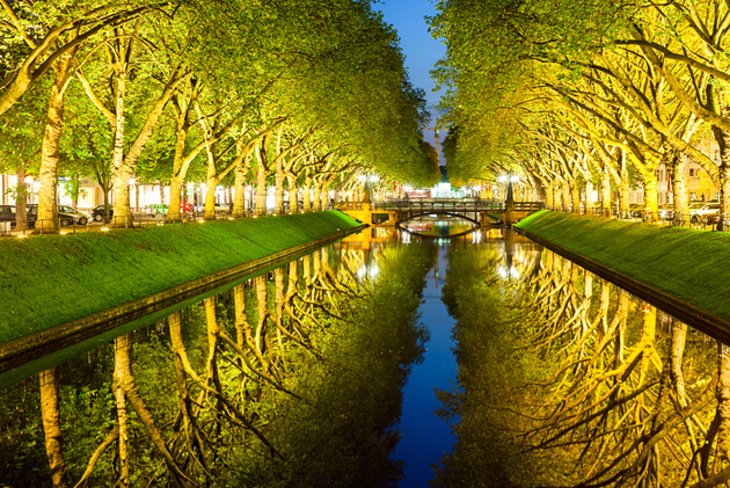
Düsseldorf's most elegant street, Königsallee – literally translated into English as "King's Avenue" – is affectionately known to locals as the "Kö" and is said to be Germany's ritziest shopping district.
Comparable to the chic Avenue Montaigne in Paris, this long stretch of high-end real estate was laid out in 1802 and continues to draw the crowds with its eclectic mix of exclusive boutique shops, designer clothing stores, and luxury shopping arcades. There's also no shortage of art galleries or restaurants and cafés.
A number of fine luxury hotels line the street, too, some of them boasting excellent rooftop patios with views over this bustling street and the city.
Extending along both sides of the old town moat – a 31-meter-wide, tree-lined stretch of water that adds to the street's sense of spaciousness – Königsallee stretches a distance of one kilometer all the way from Graf-Adolf-Platz in the south to the Hofgarten in the north. It ends at the spectacular Triton Fountain. Its entire length is a delight to explore on foot and is a must-add to your Düsseldorf travel itinerary.
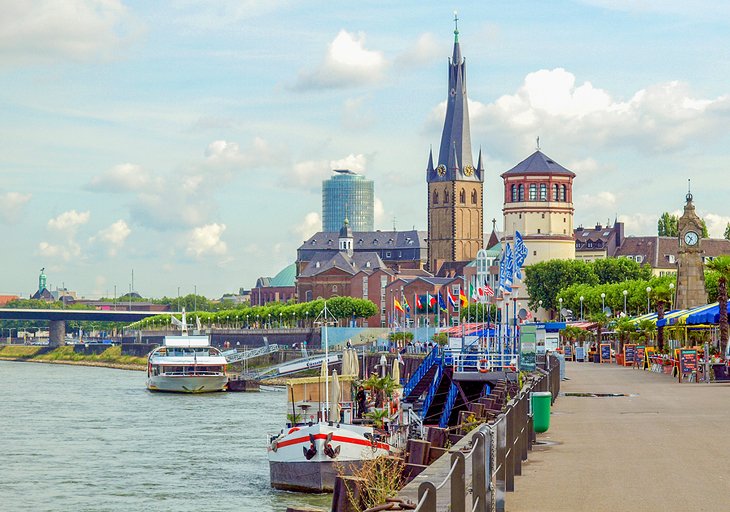
Düsseldorf's Rhine Embankment Promenade (Rheinuferpromenade) offers one of the best ways of enjoying the city's wonderful riverside. Opened in 1997 as a means of hiding one of the city's busiest roads (it's buried beneath the promenade), this long pedestrian route gives the city a distinctly Mediterranean flavor, lined as it is by cafés, restaurants, galleries, and shops on one side, and the mighty Rhine on the other.
Running all the way from the Oberkassel Bridge and connecting the Old Town to the state's Parliament buildings, the one-and-a-half-kilometer, tree-lined promenade encompasses pedestrian and bike paths and offers countless opportunities for sightseeing and people watching.
You'll find a genial mix of tourists and locals enjoying it all year long. Taking a stroll along this delightful pedestrian route remains one of top things to do in Düsseldorf at night.
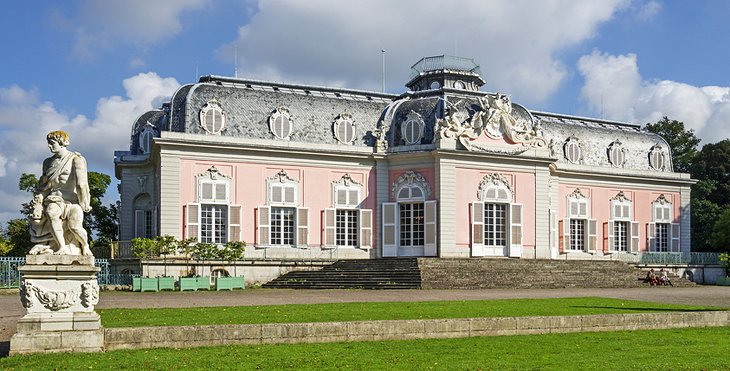
An easy 10-kilometer journey from the city center by public transit or car, Schloss Benrath (Benrath Palace) is a splendid Baroque mansion constructed between 1756 and 1773. Highlights include the palace's sumptuous interior, as well as a stroll around its huge park and gardens.
Originally built for Elector Carl Theodor, the palace is home to three excellent museums focusing on various aspects of life in the 18th century. In the main palace building is Museum Corps de Logis , showcasing the history of Benrath and its architecture.
Also located within the former place are the equally interesting Museum for European Garden Art and the Museum of Natural History are situated in other park buildings. English language guided tours are available for all museums here. The pleasant gardens, laid out in Baroque style, are also worth a visit.
Address: Benrather Schloßallee 100-108, 40597 Düsseldorf
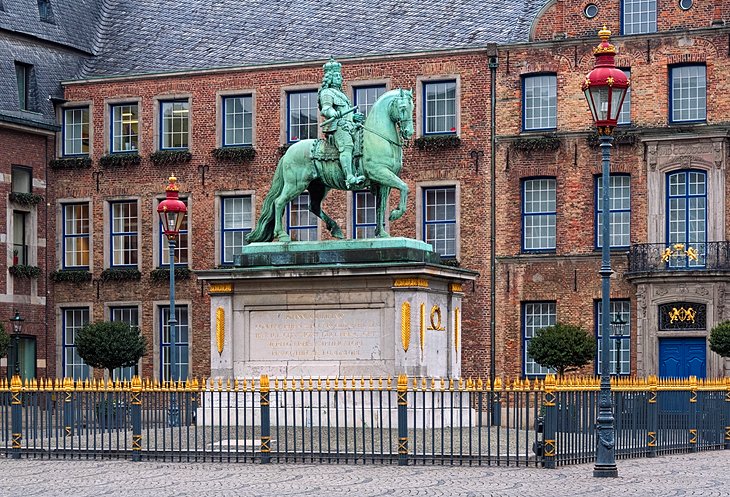
Düsseldorf's Old Town (Altstadt) remains remarkably well preserved and should be included on your list of must-see attractions. The focal point of the Old Town is the Marktplatz , where you'll find the imposing Town Hall (Rathaus) and a large equestrian statue of Elector John William II erected in 1711.
Another highlight is the Castle Tower (Schlossturm) in Burgplatz on the banks of the Rhine. The only surviving section of the old castle that once dominated the city, the tower is home to the SchiffahrtsMuseum , one of Germany's best (and oldest) marine museums with fascinating exhibits on the history of shipbuilding and trade.
Another attraction to visit is the Hetjens-Museum , dedicated to more than 800 years of ceramics, porcelain, and earthenware. St. Lambertus Church is also worth a look and is well-known for its unusual twisted spire.
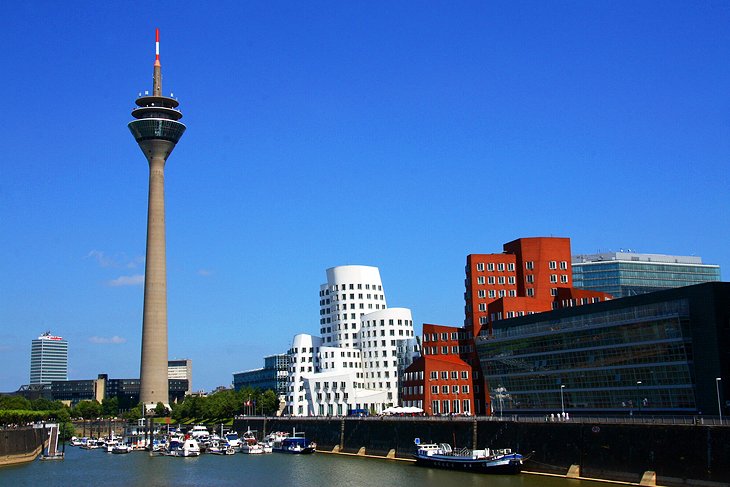
When Düsseldorf decided to reclaim the wasteland of its former river port area, instead of razing the derelict warehouses and freight yards, the city rehabilitated the most historic of them and replaced others with some of Europe's most daring modern architecture.
The best of the massive Düsseldorf-Hafen (Dusseldorf Harbor) redevelopment is in Neuer Zollhof , a stunning section highlighted by the Frank O. Gehry-designed office buildings of Medienhafen ( Media Harbor ), three quite distinct structures completed in 1998 that seem to defy gravity as they lean and curve like jelly frozen in mid-wobble.
In contrast to these modern structures, the former commercial harbor, with its walls, iron bollards and railings, cranes, and rail tracks remain as historical monuments. Topping the area off is the Rheinturm , a 240-meter-tall telecommunications tower. If you can, be sure to extend your visit to this interesting area with a meal at one of the many good harborside restaurants.
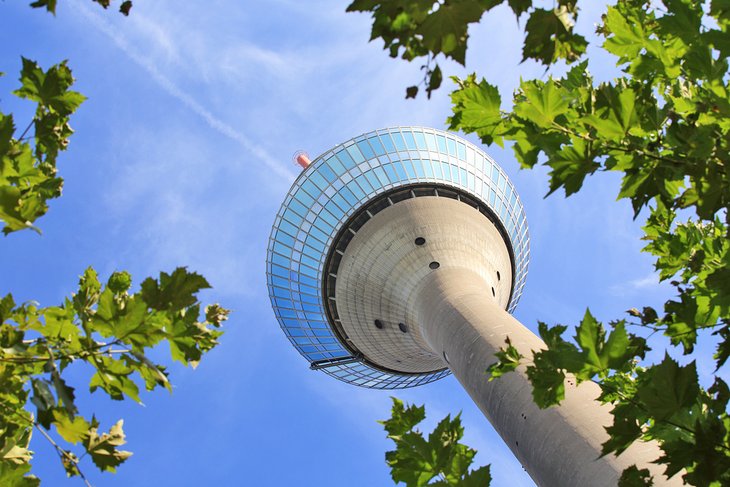
Another landmark you'll want to include on your list of sightseeing opportunities in Düsseldorf is the Rheinturm, or Rhine Tower. Set in the midst of the city's harbor area, this 240-meter-tall telecommunications tower was constructed in 1981 and features an observation deck that offers superb views of the city. For a special treat, visit late for excellent night vistas over the city far below.
Also of interest here is the Lichtzeitpegel (light time level), a fascinating sculpture that also just so happens to be the world's largest digital timepiece. A restaurant is also located atop the tower.
Address: Stromstraße 20, 40221 Düsseldorf
Official site: www.rheinturm.de/en/
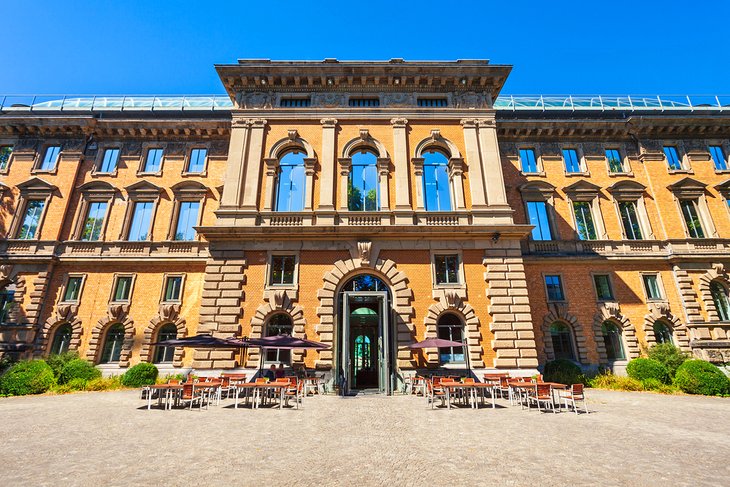
The North Rhine-Westphalia Art Collection (Kunstsammlung Nordrhein-Westfalen) is spread across three distinct locations in Düsseldorf. The largest collection, K20 , is located in Grabbeplatz, an ultra-modern building with a façade of polished black granite, which is itself a work of art. This vast gallery houses numerous works of modern art, including a notable collection of paintings by Paul Klee.
K21 , in the 19th-century Ständehaus building, includes a variety of installations focusing on modern painting and drawing, as well as sculpture and film, with works by Thomas Schütte, Reinhard Mucha, and Thomas Hirschhorn.
The third location, Schmela Haus , hosts numerous temporary exhibits. Other art-related museums of note in Düsseldorf include the Julia Stoschek Collection , a private collection of contemporary art, and the Ernst Schneider Collection . A variety of reputable dining options are available at the museum's various locations.
Address: Grabbeplatz 5, 40213 Düsseldorf
Official site: www.kunstsammlung.de/en/home.html
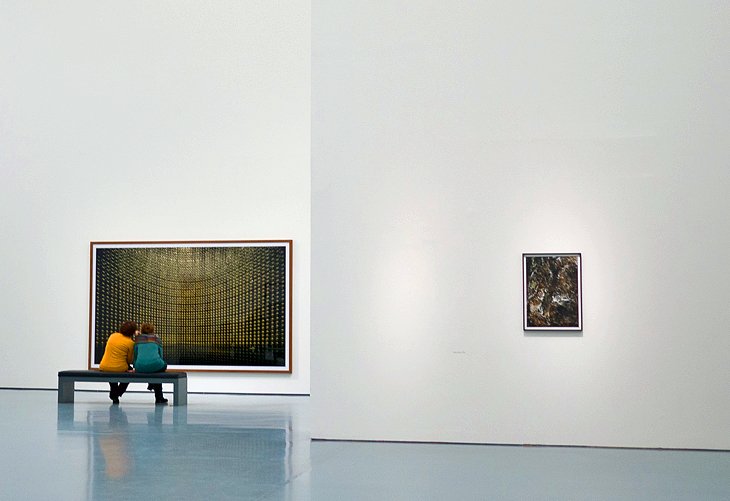
The Museum of Art (Museum Kunstpalast) displays artwork dating from the 3rd century BC right up to the present day. Works include fine art, sculptures, and drawings, in addition to more than 70,000 items of graphic art, photos, and applied art.
Highlights are a collection of glass by Helmut Hentrich and rare Italian Baroque works. The modern collection features Caravaggio, whose work laid the foundations of modern art, and works by Dali, Warhol, and members of the Düsseldorf School of Painting and Expressionism. The museum also offers theatrical performances and classical concerts, and guided tours are available.
Also of interest to art lovers is Kunsthalle Dusseldorf , a collective of local artists who regularly host displays of members' work in a unique underground gallery called Art in the Tunnel (Kunst im Tunnel).
Address: Ehrenhof 4-5, 40479 Düsseldorf
Official site: www.kunstpalast.de/en/home
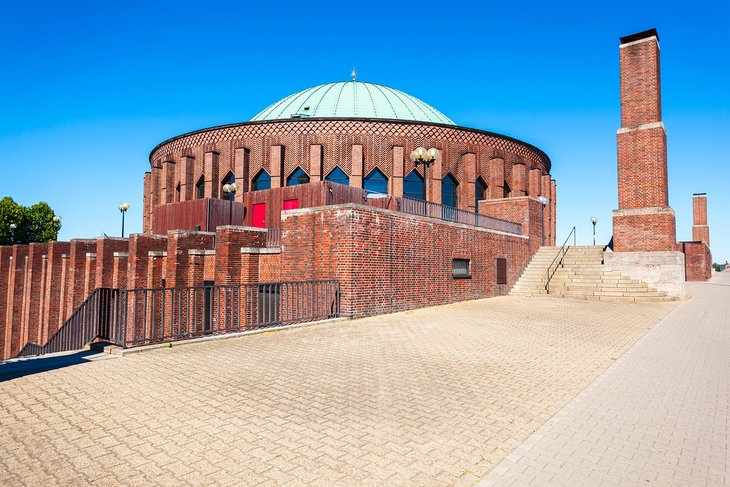
Those who enjoy high culture should be sure to visit Düsseldorf's Ehrenhof district. Here, you'll find the domed Tonhalle , a spectacular concert hall constructed in 1926 as home for the city's orchestra, Düsseldorfer Symphoniker.
The building is still the home for this world-class orchestra, and regular performances are held throughout the year. It's also used regularly as a venue for touring pop and rock artists.
Address: Ehrenhof 1, 40479 Düsseldorf
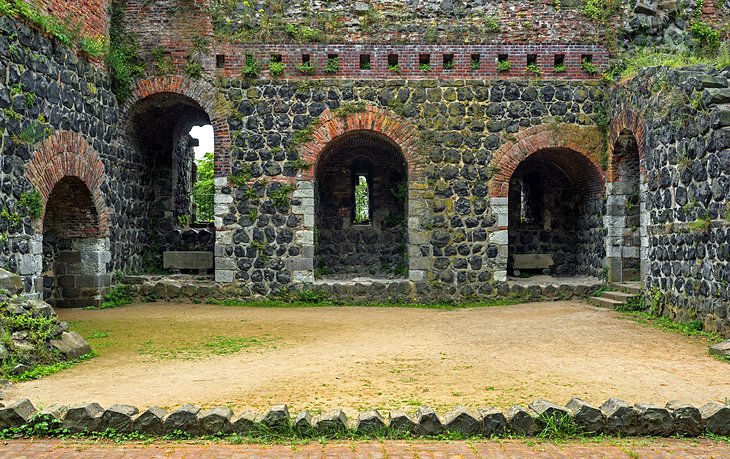
Incorporated into the city in 1929, Düsseldorf-Kaiserswerth is one of the city's oldest (and poshest) neighborhoods and is a wonderful place to explore Baroque buildings and the picture-perfect location on the Rhine.
Be sure to allow plenty of time to wander its pleasant cobbled streets, popular among tourists for its traditional German shops selling food items and crafts. There are also a number of good art galleries here, including the Kaiserswerth Art Archive (Kunstarchiv Kaiserswerth), plus pleasant cafés and restaurants.
Tracing its roots back to the 13th century is the Church of St. Suitbertus , noted for its beautiful reliquary of the saint. Even older is the Kaiserpfalz , the imperial stronghold of Emperor Frederick I, also known as Barbarossa. Although mostly ruins, the scale of the site still impresses, with walls more than four meters thick. The ruins also serve as a great vantage point for excellent views over the Rhine.
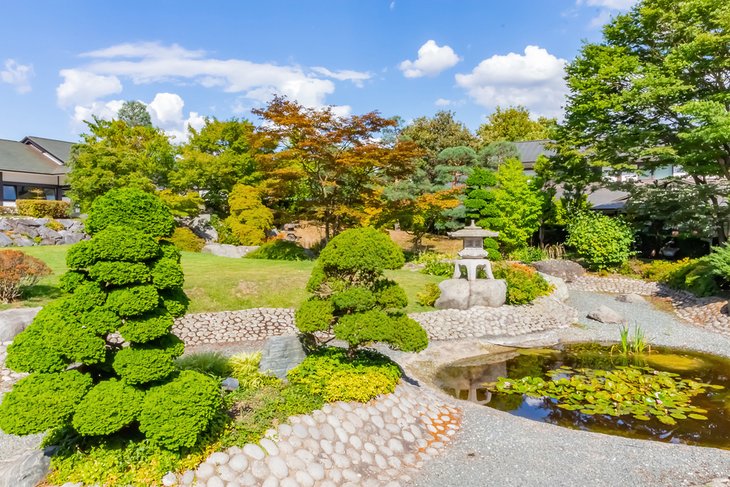
Among the more unusual things to do in Düsseldorf is to take a stroll through a serene Japanese garden. One of Düsseldorf's most popular parks – and at 90 acres, one of its largest – Nordpark is crisscrossed by wide pathways through its spacious lawns and themed gardens, including the lovely Lily Garden.
The large Japanese Garden, presented to the city by Düsseldorf's Japanese community, has an astonishing variety of landscapes.
Other Nordpark highlights are its Horse-Tamers statue, and the Aquazoo Löbbecke Museum , a great place for kids of all ages thanks to its excellent natural history displays, large aquarium, and insectarium.
Address: Kaiserswerther Str. 365, 40474 Düsseldorf
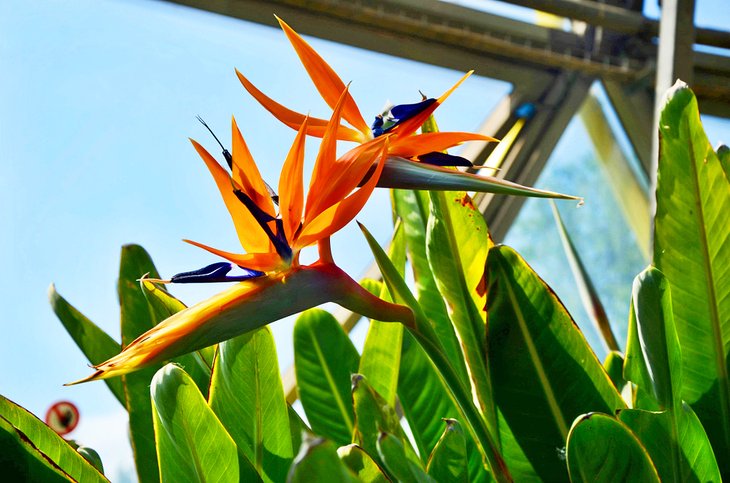
Green thumbs will also enjoy the Botanical Garden of Düsseldorf (Botanischer Garten Düsseldorf). Located just to the south of the city center on the grounds of the University Düsseldorf, the gardens spotlight plants from temperate climate zones and also feature a domed hot house, wildflower meadow, beehives, and delightful apothecary and Alpine gardens.
This impressive plant collection was established in 1974, and consists of more than 6,000 species. Guided tours are available, and a variety of changing exhibits are hosted in the site's Orangery.
Address: Universitätsstraße 1, 40225 Düsseldorf, Germany
Official site: www.botanischergarten.hhu.de/en/
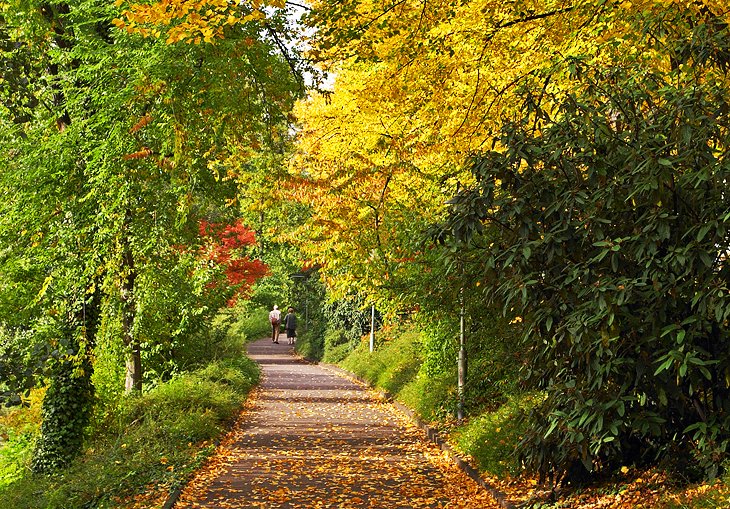
To the north of Düsseldorf's city center is the Hofgarten, a large park laid out in 1770 that stretches all the way from the Old Town and Königsallee to the banks of the River Rhine. Designed in the English landscape style, this lovely 68-acre site includes extensive meadows and wooded areas, as well as numerous streams and ponds.
Among its many notable buildings is the Baroque Hofgärtnerhaus , or Court Gardener House, former home of garden architect Maximilian Weyhe and now housing the city's Theatre Museum (Theatermuseum Düsseldorf).
Also worthy of a visit is Schloss Jägerhof , a former hunting lodge built in Rococo style in 1763 and occupied, albeit briefly, by Napoleon. Today, the building is home to the city's Goethe Museum , with its rich collection of artifacts and exhibits devoted to Germany's greatest writer and poet.
The park is also home to a number of interesting modern sculptures, as well as historic monuments and memorials, including the Märchenbrunnen, with its fairy-tale figures, and a sculpture by Henry Moore.
Address: Jacobistraße 2, 40211 Düsseldorf
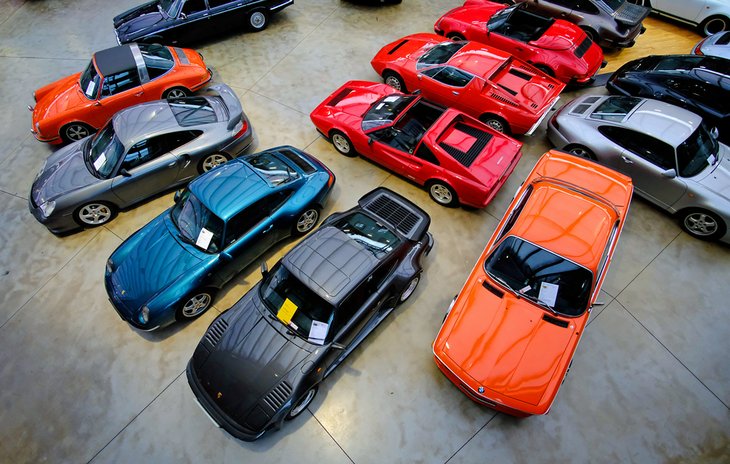
An historic roundhouse for locomotives finds a new calling as the home of Classic Remise Düsseldorf, a center for all things relating to classic cars. It's a car-lover's paradise and is really a combination show room, repair and restoration facility, parts shop, auto storage facility, and shop for auto-related clothing and gifts.
A particularly unusual feature is the number of glass storage "boxes" where owners can store cars securely while leaving them visible to aficionados. The facility also doubles as an event venue, too.
Address: Harffstr. 110 a, 40591 Düsseldorf
Official site: http://remise.de/Classic-Remise-Duesseldorf-english-summary.php
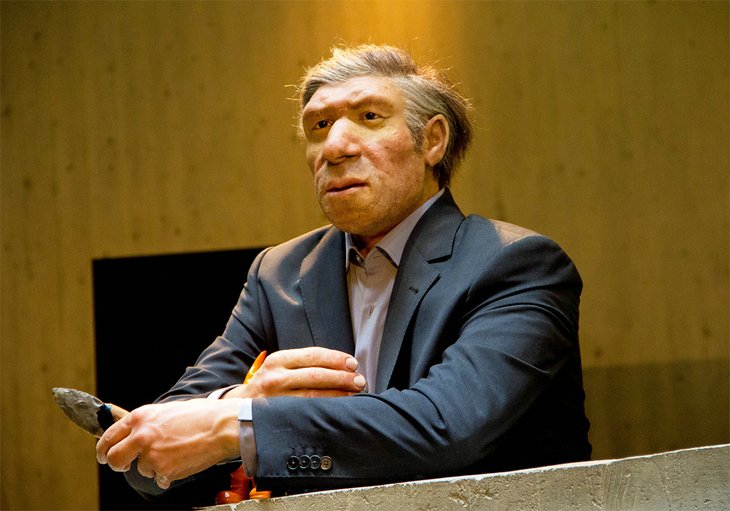
Just 25 minutes' drive (or 40 minutes via public transit) from Dusseldorf, the fascinating Neanderthal Museum is a must-do if there's time in your Germany travel itinerary. It was here in the Neandertal valley that the very first Neanderthal man was unearthed.
Opened in 1996, the museum provides an opportunity to have your photos taken with remarkably life-like waxworks of Neanderthals, along with ancestors from our direct branch of the human family tree. Other notable features include an archaeological park to explore, a reproduction of a workshop from the Stone Age, and artwork representing mankind's evolution. English language audio guides are provided.
The museum is located on the route of a 243-kilometer trail network; if you can manage the walk, (an hour each way), you can explore attractive downtown Mettmann from here.
Address: Talstraße 300, 40822 Mettmann
Official site: www.neanderthal.de/en/
If you're a first-time visitor to Düsseldorf and plan to see the city's top tourist attractions, the best place to stay is along the Königsallee. Known locally as the "Kö," it's here you'll find the city's most exclusive shopping street with its designer boutiques, jewelry stores, and stylish restaurants and cafés. Steps away from the Königsallee, Dusseldorf's Old Town (the Altstadt) is also a popular area to stay. Below are some highly rated hotels in convenient locations for sightseeing:
Luxury Hotels:
- In one of the best locations on the Königsallee, the pet-friendly Breidenbacher Hof, a Capella Hotel makes a great base for sightseeing, with a pool and cozy living room for guests, as does the InterContinental Dusseldorf , also on the Königsallee.
- Both these hotels lie within walking distance of the Rhine promenade and the Old Town. A little out of town but in a beautiful location on a peninsula of the Rhine, the Hyatt Regency Düsseldorf is just a 15-minute walk along the river from the Old Town, yet only a five-minute walk to the Media Harbour with its trendy restaurants and entertainment venues.
Mid-Range Hotels:
- Near the main train station and a 12-minute walk from the Königsallee, the Max Hotel Garni is an intimate boutique hotel with clean, modern rooms.
- Also within easy walking distance to the city center, Sir & Lady Astor Hotel is another boutique option, with elegantly furnished rooms and good-value rates.
- If you're seeking larger contemporary accommodations in the mid-range category and appreciate a great breakfast buffet, Hotel National lies a 20-minute walk or one stop on the metro from the Old Town.
Budget Hotels:
- The Holiday Inn Dusseldorf City - Toulouser Allee is a great budget option within close proximity of the heart of the Old Town, but you can save money by staying a little out of town and taking public transport to the main sites.
- The affordable Ibis Duesseldorf City lies within easy access by public transport to other attractions.
- Also close to the station (it's right next door) is Ibis Duesseldorf Hauptbahnhof , also just a short walk to the Königsallee shopping area.
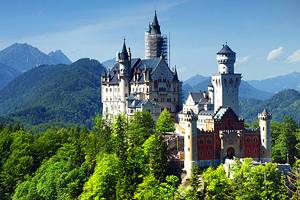
Exploring the Rhine Valley: Düsseldorf's location on the Rhine in western Germany makes it a very handy starting point for exploring the top attractions of the Rhine Valley , which can be explored via fun hop-on, hop-off river tours departing from the historic old university town of Mainz .
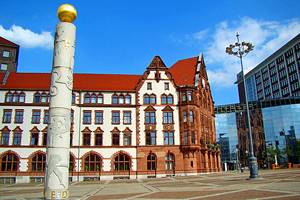
More Destinations near Dusseldorf: Other travel options easy to execute from Düsseldorf include visiting the attractive city of Dortmund , popular for its pedestrian-friendly Old Market square (Alter Markt) and its 13th-century church. Another must see destination that's close by is the charming Dutch city of Maastricht , famous for its 6th-century church dedicated to Saint Servatius and its medieval city walls.
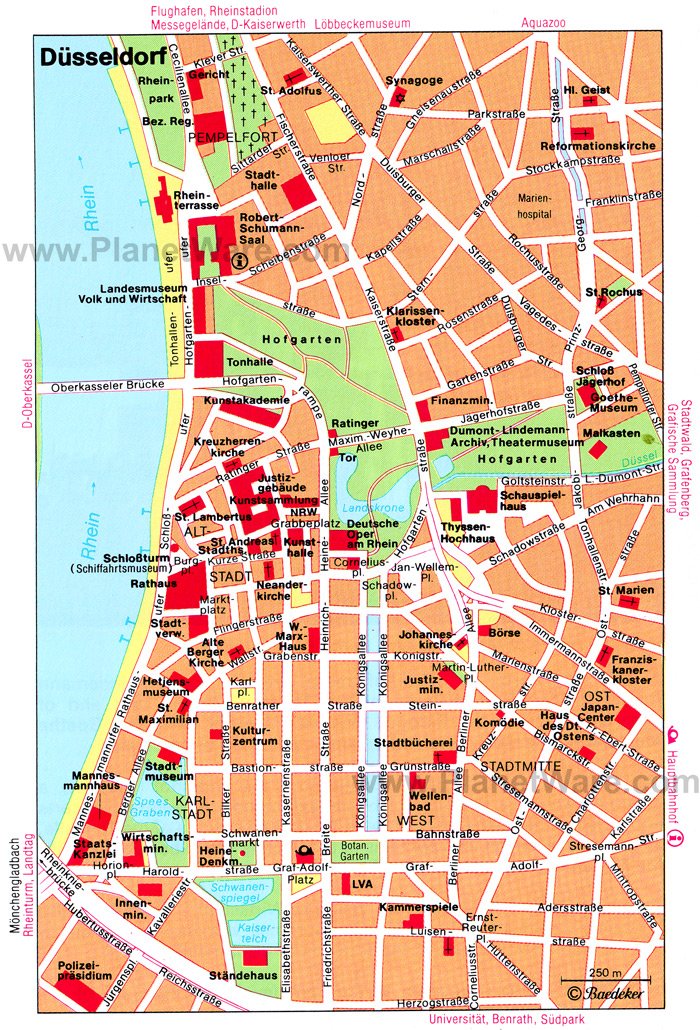
More on Germany

🙌 Awesome, you're subscribed!
Thanks for subscribing! Look out for your first newsletter in your inbox soon!
Get us in your inbox
Sign up to our newsletter for the latest and greatest from your city and beyond
By entering your email address you agree to our Terms of Use and Privacy Policy and consent to receive emails from Time Out about news, events, offers and partner promotions.
Awesome, you're subscribed!
The best things in life are free.
Sign up for our email to enjoy your city without spending a thing (as well as some options when you’re feeling flush).
Déjà vu! We already have this email. Try another?
Love the mag?
Our newsletter hand-delivers the best bits to your inbox. Sign up to unlock our digital magazines and also receive the latest news, events, offers and partner promotions.
- Things to do
- Attractions
- Restaurants
- Los Angeles

Travel tips every first time Düsseldorf visitor needs to know
First time in tech-town? Get to know the city with our selection of travel tips for first-time visitors to Düsseldorf
Hitting up Düsseldorf for the first time? We’ve got some tips for you. Over the last century or so, Düsseldorf has developed from a collection of disparate villages into one of the most exciting cities in Germany, a hub of innovation and culture that attracts visitors, entrepreneurs and adventurers in equal measure. The ‘traditional yet modern’ cliche is alive and well here, with a community vibe that juxtaposes that glittering skyline and business-friendly mentality of the city. Our collection of travel tips for first-time visitors to Düsseldorf will help you navigate the city and make the most of this marvellous place, with its impressive range of restaurants and exciting attractions .
RECOMMENDED: The 19 best things to do in Düsseldorf
Been there, done that? Think again, my friend.
1. The world revolves around the tower

Getting your bearings in Düsseldorf can be hard. With neither a “true” downtown nor an easily discernible pattern to the street layout, the easiest way to determine where you’re at is to look for the round television tower, the Rheinturm, located amid the Medienhafen and directly on the river. It’s also a great place to grab a drink and see the skyline.
2. Learn how to order

Visitors are often shocked at the lack of friendliness by customer service personnel. The first place many visitors notice this is in cafes or restaurants, where servers only come to you when called—and called in the right way. Snapping your fingers, whistling or calling out garcon is the epitome of rudeness. A raised hand and wave in their direction will suffice. In breweries, you can also order another by simply making eye contact with the server and giving the thumbs-up sign, signifying the number one.
3. Dress to impress

One of Germany’s wealthiest cities, Düsseldorf is also one of the country’s most fashion-conscious destinations. Although torn denim and sneakers are more acceptable attire today than they were just a few years ago, there is still an unwritten dress code in many establishments. If you’re headed to the Oper am Rhein or embarking on a shopping spree on the Kö , make sure to dress the part or risk being turned away at the door. You can leave the penguin tails at home—just don’t show up in flip-flops and tank tops.
4. A cold stare is a form of greeting

Don’t take it personally if no one says hello as you pass by. Or when you walk into a store. Or even in a restaurant when someone comes to take your order. Germans are a formal bunch and an expressionless nod is often used as a polite form of greeting—and one you should reciprocate.
5. This city can be sleepy

For a city of more than one million inhabitants and with several universities, Düsseldorf can be eerily quiet late at night. While pubs and clubs in the Altstadt—especially around Bolker Strasse or Ratinger Strasse—are open every day, in other neighbourhoods finding something doing after 10pm on a weekday can feel near-impossible. One area to look is Bilk, the student district, or Pemplefort, filled with bars and restaurants which get lively on warm summer days.
6. Don’t miss the (free) art

Home to the Arts Academy that counts Joseph Beuys, Gerhard Richter and Andreas Gursky as alumni and where some of the biggest artists of the 20th century have taught, Düsseldorf has a reputation as a leading arts centre to uphold. Grab an Art:card from the Tourist Office and get entry for a year to most of the city’s museums. Or check out the K20 and K21 Museums after 6pm on the first Wednesday evening of every month for free entry. Just be sure to note: most museums are closed Mondays.

7. …It’s not just in museums!

Lovers of modern and contemporary art will feel drawn to the more than 100 galleries dotted around the city, especially in the Stadtmitte neighbourhood. Openings occur nearly every weekend and since 2017, the city plays host to its own annual art fair.
8. Japanese culture is everywhere

Home to Europe’s third-largest Japanese community, Düsseldorf celebrates the contributions of the country’s immigrants with a city-wide party and awesome fireworks display over the Rhine on one of the last weekends in May. If you’re here at another time, check out the area around Schadowstrasse for some of the best Japanese food in Germany.
9. Keep cash on hand

No matter what you’re doing or where you’re going, it’s always a good idea to keep cash on you. Although Düsseldorf is home to loads of start-ups and new media companies, banking is still behind the times. Few taxis, pubs and dining establishments take credit or bank cards and even fewer places are set up for mobile pay. The pandemic has changed this somewhat, but better to be safe than sorry.
10. Make a shopping bee-line for the Kö-Bogen

Königsallee is one of Germany’s most expensive shopping streets, with luxury goods stores like Gucci and Chanel drawing shoppers from around the world. Divided by a canal and lined with chestnut trees, the kilometre-long boulevard is one of the city’s prettiest streets. Bordering the Altstadt, it runs from the city’s main park, the Hofgarten , and is filled with fantastic architecture, including the Kö-Bogen shopping mall, designed by Daniel Liebeskind.
11. There’s media in Media Harbor

Düsseldorf is not only Germany’s fashion capital, it’s also home to hundreds of advertising agencies, publishing houses and several television studios. It is a place concerned with appearances and nowhere is that more apparent than at the Medienhafen , the city’s upscale riverfront office district with buildings designed by Frank Gehry that are well worth a look.
12. Round up to tip

Tipping in Germany is a polite show of appreciation, but don’t go overboard. Most servers and taxi drivers are happy if you round up to the nearest Euro or two and will look at you funny if you approach even ten percent of the bill.
13. Altbier is no joke

It bears repeating that not all beer is created equally. The top-fermented lager native to the region may be low in price, but not in alcohol content. Drink slowly. Drink wisely. And while drinking, keep in mind that public toilets are a rarity.
14. Watch traffic while on trams

Düsseldorf has an extensive public transportation network comprised of U-Bahn (underground subways), S-Bahn (suburban rail), buses and trams. The trams, denoted by their numbers 701-709, run on tracks in the middle of busy city streets, so while boarding and exiting, it’s vital to stay aware of traffic. Pedestrian-tram accidents are increasingly common so pay attention, especially with earbuds in.
15. Always stamp your ticket

Public transportation runs on the honour system, with authorities often boarding mid-trip to ensure everyone has a valid ticket. You can buy your ticket from a machine onboard (not the driver) and be sure to time-stamp it—or risk a fine.
16. This is a cycling city

With lots of parks and marked bike lanes, Düsseldorf is a great city to see by bike. Bike-sharing is simple and easy using the FordPass mobile app/DB Call a Bike program. But remember that bikes are subject to the same rules of the road as vehicle traffic: stop at red lights, don’t turn right on red and make sure your lights are on after dusk.
17. if it’s late, hail a taxi

With no official closing times, club nights can bleed into the wee hours of the morning. Planning a night out? Figure in cab fare for the ride home, as public transport runs sporadically after midnight and before dawn.
18. Be aware of Karneval closings

Germany’s Rhineland region celebrates the start of Lent every year by throwing a five-day party before the fasting begins. Beginning at 11:11 on Weiberfastnacht (Ladies Night) on the Thursday before Ash Wednesday (usually in mid-February to mid-March), the streets are flush with drunken revellers. Most bars are open, but many shops are closed for the party, which carries on through the following Tuesday. One highlight is the Rosenmontag parade on Monday, filled with drum corps, dancers and floats poking fun at politics. Though it may not be fun for everyone, it’s definitely worth a visit at least once.
19. Beware of swift currents

The Rhine may be the city’s centrepiece, but dipping more than a toe into the busy shipping channel isn’t a wise idea. Grab a beer and hang out riverside (not too close to the edge) or take a boat cruise down to nearby Cologne if the water’s calling.
20. Sundays are for strolling

German law has that most shops remain closed on Sundays, and the centuries-old rule has created a culture of Sunday walkers. One of the best places to bust out your walking shoes is the Rhine Promenade. If green parks are more your style, the botanical gardens surrounding Benrath Castle have plenty of paths to get lost in your thoughts.
Time to explore
The best things to do in düsseldorf.

This medieval city on the banks of the Rhine recently celebrated its 730th birthday, but Düsseldorf isn’t resting on its historic laurels. With a slew of cutting-edge architecture and a booming arts scene both above and below ground, the capital of the of the North-Rhine Westphalia state is fast becoming one of Germany’s most lively metropolises.
[image] [title]
Discover Time Out original video
- Press office
- Investor relations
- Work for Time Out
- Editorial guidelines
- Privacy notice
- Do not sell my information
- Cookie policy
- Accessibility statement
- Terms of use
- Modern slavery statement
- Manage cookies
- Advertising
- Time Out Market
Time Out products
- Android app
- Time Out Worldwide

The Perfect 1, 2 or 3 Days in Dusseldorf Itinerary
Last Updated on February 20, 2024
by Paola Drexler
Disclaimer: This article contains affiliate links. That means if you click a link and make a purchase, we may make a small commission. As an Amazon Associate we earn from qualifying purchases. For more information, see our privacy policy.

Whether you like historical or modern architecture, you’ll get both beautifully blended in Dusseldorf. As Germany’s fashion capital and with a big international business hub, there are tons of interesting things to do when planning a 1, 2 or 3 days in Dusseldorf itinerary.
For those who love shopping, visiting museums or wish to visit the world’s longest bar, there’s certainly a dedicated street for you – there’s even a place for cartwheel lovers. In Dusseldorf, you’ll find something for everyone!
Table of Contents
How Many Days in Dusseldorf?
With such a fascinating city like Dusseldorf, you can get lost and spend days in the city exploring every quaint corner. However, when the circumstances don’t allow it, you might be contemplating how many days to spend in Dusseldorf. But we can help you make that decision.
For travellers with limited time, 1 day in Dusseldorf can give you a wonderful overview of the city. While it may leave you with little downtime, you’ll get to see the main sights.
If you have a bit more time to play around with, 2 days in Dusseldorf is plenty of time to do the city justice and even have some wiggle room to explore additional activities.
For those with more flexibility, 3 days allows you to venture outside the city centre, to places within wider Dusseldorf or even surrounding cities.

Getting To & Around Dusseldorf
Dusseldorf is easily accessed by different forms of transportation, whether you prefer flying or driving, or using other methods. Dusseldorf is well-connected by train to several different German cities, such as Cologne , Berlin , Munich and Hamburg . You can view train schedules here.
When flying into Dusseldorf, you’ll find the main airline carriers and direct flights flying into the closest airport which is handily the Düsseldorf Airport.
This airport is located 10 minutes away by car or just 20 minutes by train from the city centre. The next closest airport is the Cologne Bonn Airport but requires about an hour to reach Dusseldorf once landed. You can organise private transfers from the airport.
Getting around in Dusseldorf is done with ease since many of the main sights are within walking distance but for further attractions trains and buses are also available. Travellers can purchase a Düsseldorf Card that comes with extra perks.
When you decide on a longer stay for your Dusseldorf itinerary, it’ll be helpful in saving money on the Düsseldorf Card since one day starts at €12.90 and the more days you purchase the less you spend each day.
With the card, you won’t just receive free rides on public transportation but also discounts or free entry around the city at certain attractions, museums, tours and restaurants.
With the river flowing through the city, an additional way to explore the city is by riverboat. So once you’ve seen all there is to see, you can relax floating down the river and enjoying Dusseldorf from the water.

1, 2 or 3-Day Dusseldorf Itinerary
As mentioned, in Dusseldorf you’ll find an excellent balance between historic and modern in one city. On the first day, you’ll be able to see how well the city blends together.
Day 1 – MedienHafen, Altstadt and Konigsallee
Although only 1 day in Dusseldorf can feel a bit packed, it will be filled with most of the must-see sights in the city centre. For extra guidance, you can book a walking tour to make sure to cross all the items on your list, which is a great option if you’re only planning to visit Dusseldorf in a day.
You’ll begin your trip on the southern side of the banks of the Rhine river in the Media Harbour. Here you’ll find uniquely beautiful buildings as well as the impressive Rhine Tower that towers over the city.
At the top of the tower, you’ll find the rotating restaurant QOMO and the viewing platform that is open for visitors to enjoy the breathtaking city’s panoramic views. On good days you might even spot the Cologne Cathedral over 40km (25 miles) away.
After getting a magnificent look at the city from above, let’s continue up the river towards Altstadt. On the way, you’ll walk on the Rheinuferpromenade or Rhine Embankment Promenade, which is one of the most popular promenades on the Rhine. As you stroll on the riverside you’ll see many cute shops and cafes, so you can grab a drink and enjoy the view.
Altstadt, Burgplatz and Hofgarten
Once you reach Altstadt or Old Town in English, you’ll know you’ve found the heart of the metropole since it’s the oldest part of the city and you’ll notice many of the old but beloved landmarks. Some of the landmarks dating back to the 13th century like the Castle Tower and St. Lambertus Church.
The Schlossturm or Castle Tower, which is located on the Burgplatz square, was once part of the Dusseldorf Castle that was built in 1260. Today the tower is the only part of the castle that still remains. Inside the tower, you will find the Rhine Maritime Museum which showcases the city’s transportation history on the water.
Also in Burgplatz, you’ll find the very interesting Cartwheeler’s Fountain, which honours the city’s old tradition of cartwheeling for joyous occasions.
As you head towards Hofgarten, you’ll pass by the St. Lambertus Church which, apart from being a grand historical Catholic church in Old Town, is believed to be the oldest landmark in Dusseldorf. The church is also known for inspiring one of the largest public festivals in Germany, the Rheinkirmes, which is still celebrated in Dusseldorf every July.
As you continue east on Ratinger Straße, you’ll walk until you see the Ratinger gate where you’ll reach the Hofgarten, known as not only Germany’s oldest but its first public garden. Here you will leisurely stroll through the park until you see the Jägerhof Palace.
Depending on the time, feel free to take a peak inside, or head straight to the next destination. Interesting fact: the palace was built in the 17th century and was once a hunting lounge, but now it houses the city’s Goethe Museum and Ernst Schneider Foundation.
Walking back to the Ratinger gate, you’ll follow Heinrich-Heine-Allee Street to the Konigsallee.

Konigsallee
End your first day on the elegant Konigsallee street – the city’s main shopping street along the beautiful canal.
Whether you’re a serious shopaholic or just an admirer of clothes, you’ll find whatever you are looking for on the Konigsallee, also known to locals as the “Ko.” Not only is it home to some of the biggest luxury brands, but you will also find popular restaurants and cafes on this street.
Head to a local bar or join a brewery tour and maybe enjoy an Altbier — a style of beer native to the Rhineland (and Dusseldorf specifically).
As you can see, there are plenty of things to do in Dusseldorf in one day. Should you have limited time, you’ll be able to get through the highlights, but if you’re in search of more, then let’s continue to the second day.
Day 2 – Nordpark, EKO-Haus and Botanical Garden
The second day of your Dusseldorf itinerary will begin on the northern side of the city on the Rhine River. You’ll slowly make your way to the south later on in the day.
Nordpark and EKO-Haus
Nordpark translates to North Park and you’ll soon see how it differs from other parks in the area, as well as the opposing Südpark.
In this park, you’ll find vibrant colours all around you in flowerbeds and trees, along with its various ponds, water features and themed gardens. You’ll find serenity in the park’s lily or Japanese garden.
From the park, you’ll walk down the river to the Theodor-Heuss bridge and walk across the river to the EKO House of Japanese Culture.
With one of the largest populations of Japanese in Dusseldorf compared to other European cities, you’ll notice the strong influence and representation it has in the city, for example with food and cultural centres. The city is sometimes referred to as “Japan am Rhein” or “Little Tokyo.”
At the EKO House, you’ll feel like you’ve walked from Germany into Japan in seconds. The centre includes stunning Japanese gardens, cherry blossom trees, Japanese-inspired houses and a Buddhist temple.

Rhine River Cruise
After having walked all around the city on the first day, after the EKO House, your second day will continue with a leisure boat ride on the Rhine River so you can take in the beautiful city and see it through a different lens as you head to the southern part of the city. You can book an hour cruise here.
From the Rheinuferpromenade, you’ll head northeast to the underground at Heinrich-Heine-Allee. Take a train to the Kettwiger Straße stop which is a short 5-minute walk away from your next destination.
Kiefernstraße and Botanical Garden
The fascinating street of Kiefernstraße is filled with colourful graffiti on almost every possible surface, including buildings, trailers, trashcans and more. Once you’re finished admiring the art, you can walk or hop on a U-bahn south towards Dusseldorf’s botanical garden.
The garden, which is taken care of by the University of Dusseldorf, has over 6,000 different species with about 400 coming from all over the world including South Africa, Chile, Asia, and the Mediterranean. There are more than plenty of plants to admire and learn about.
After the botanical garden, you’ve completed your 2 days in Dusseldorf but if you still haven’t had enough, you can add an additional day to your trip.
Day 3 – Museums, Schloss Benrath or City Day Trip
For those who have an extra day to spend in the area, this is a great opportunity to visit museums you’re interested in and to take a day trip to cities nearby or on the way to your next destination.
Museums in Dusseldorf
For those spending 3 days in Dusseldorf, there are many museums to explore like the Kunstsammlung, which holds the regional art collections of the state of Nordrhein-Westfallen or the Museum Kunstpalast which holds a wider variety of art collections.
For travellers who prefer exploring the underwater world, the Aquazoo Loebbecke Museum in Nordpark gives you a look into life underwater with about 500 different species, including sharks, penguins, stingrays and more.
The Aquazoo is at the top of the list of visitors’ favourite museums in Dusseldorf, since opening in 1987.
Benrath Palace and Essen
Just 25 minutes outside the city centre, you’ll find the lovely Benrath Palace. While touring the palace, travellers can admire the impressive interiors, gardens and parks. Along with its beauty, you can learn about its long history which starts with the construction of the palace in 1756.
Benrath is nicely located on the way from Dusseldorf to Essen so you can spend the morning at the palace and then take a look at the city of Essen.
Essen is known as one of Europe’s Green Capitals. You’ll find that the interesting architecture of the rust-coloured Zollverein Complex was not only important for the coal mining history of the city but also for becoming a UNESCO site after closing its doors. Today you can also find the Red Dot Design Museum and Ruhr Museum in the complex.

Cologne Day Trip
A great day trip from Dusseldorf is Cologne since it’s just a short 25-minute train ride or 45-minute drive away. You can visit the Cologne Cathedral and other attractions in the area or take a boat ride on the Rhine to see as much of the city as possible.
You choose which side you’re leaning towards in the friendly rivalry that locals from Cologne and Dusseldorf have fostered for centuries.
Where to Stay in Dusseldorf
the niu Tab – This 3-star hotel located in the centre of Dusseldorf is a great choice for mid-range visitors to the city. There are a myriad of bright and clean rooms on offer, daily breakfast and an on-site restaurant/bar and terrace to enjoy.
Carathotel Düsseldorf City – Those after a luxury stay in this German city will love this sophisticated hotel close to all of the top attractions in Dusseldorf. They have lovely rooms to choose from and countless amenities to ensure you have a wonderful stay.
Centerapartments Marienstrasse – If you’re looking for your own space while visiting Dusseldorf you’re sure to love these centrally located apartments. With a wide array of different flats to choose from varying in size, they all come fully furnished and equipped with everything you may need during your stay.
City Youth Hostel Dusseldorf – This hostel is perfect for budget or solo visitors to Dusseldorf. They have a number of both dorms and private rooms on offer, good common areas and self-catering facilities and a great location for exploring the city.
Not quite what you’re looking for? Click here to browse more Dusseldorf hotels!
Now that your Dusseldorf adventures are all planned out, you can daydream about your trip ahead. No matter the length you decide on for your stay in Dusseldorf, you’ll leave with many fond memories of your trip.
Are you planning a visit to Dusseldorf? Have any questions about this itinerary? Let us know in the comments!

Related Posts:

The Perfect 2 to 3 Days in Hamburg Itinerary

The Perfect 3-Day Black Forest Itinerary

Is Berlin Expensive? A Guide to Prices in Berlin

About Paola Drexler
Paola is a writer for The World Was Here First. Originally from the state of Arizona in the USA, she lived in Germany before moving to the United Kingdom. Paola loves spending her free time travelling in Europe and sometimes ever further afield.
Leave a Comment Cancel reply

IMAGES
VIDEO
COMMENTS
And there’s so much culture you may not know where to begin: The city has historic residences and parks built by Imperial Electors, art museums for all eras, cultural centres and medieval churches. Let’s explore the best things to do in Düsseldorf: 1. Rheinuferpromenade. Source: Andrey Shcherbukhin / Shutterstock.com. Rheinuferpromenade.
1. Walk along Königsallee, Germany's Most Elegant Avenue. 2. Enjoy a Riverside Stroll on the Rhine Embankment Promenade. 3. Drive to Schloss Benrath. 4. Explore Old Town Düsseldorf. 5. Düsseldorf-Hafen & Neuer Zollhof. 6. See the Views from the Rhine Tower (Rheinturm) 7. View the North Rhine-Westphalia Art Collection. 8.
Things to Do in Düsseldorf, Germany: See Tripadvisor's 202,079 traveler reviews and photos of Düsseldorf tourist attractions. Find what to do today, this weekend, or in September. We have reviews of the best places to see in Düsseldorf. Visit top-rated & must-see attractions.
The 19 best things to do in Düsseldorf right now. Get your fill of culture, beer, shopping and plenty more with our pick of the absolute best things to do in Düsseldorf. Thursday 7 December...
Here are 20 travel tips every first time Düsseldorf visitor needs to know, from travel info to tipping etiquette.
For those who love shopping, visiting museums or wish to visit the world’s longest bar, there’s certainly a dedicated street for you – there’s even a place for cartwheel lovers. In Dusseldorf, you’ll find something for everyone!